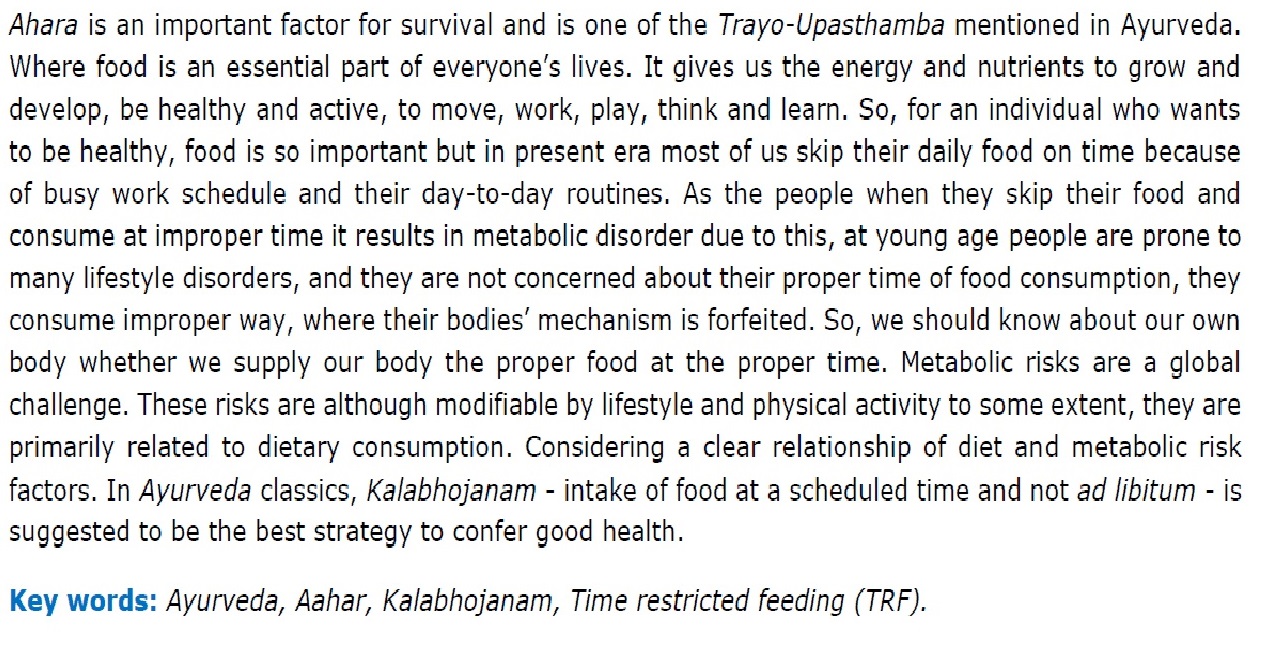Importance of Kalabhojanam to maintain health
Keywords:
Ayurveda, Aahar, Kalabhojanam, Time restricted feeding (TRF)Abstract
Ahara is an important factor for survival and is one of the Trayo-Upasthamba mentioned in Ayurveda. Where food is an essential part of everyone’s lives. It gives us the energy and nutrients to grow and develop, be healthy and active, to move, work, play, think and learn. So, for an individual who wants to be healthy, food is so important but in present era most of us skip their daily food on time because of busy work schedule and their day-to-day routines. As the people when they skip their food and consume at improper time it results in metabolic disorder due to this, at young age people are prone to many lifestyle disorders, and they are not concerned about their proper time of food consumption, they consume improper way, where their bodies’ mechanism is forfeited. So, we should know about our own body whether we supply our body the proper food at the proper time. Metabolic risks are a global challenge. These risks are although modifiable by lifestyle and physical activity to some extent, they are primarily related to dietary consumption. Considering a clear relationship of diet and metabolic risk factors. In Ayurveda classics, Kalabhojanam - intake of food at a scheduled time and not ad libitum - is suggested to be the best strategy to confer good health.
Downloads
References
P.S. Rao (2005) Ashtanga Sangraha (vol-1)- Sutra 20/2, Choukhamba Krishnadas Academy, Varanasi, India.
Motilal Banarasi Das (1963) Astanga Hridaya Sarvanga Sundari Tika commentary by Sh. Lal Chandra Vaidya: Sutra 13/6, Varanasi, India.
K. Park parks textbook of preventive and social medicine twentieth edition 2009. Page no. 13.
Prof. K. R. Srikantha Murthy Astanga Hrdyam edition reprint 2011 page no 119.
Dr. Nandini Dilip Dhargalkar Sarira kriya vidana part II first edition 2008 chapter 6.1
Prof. K. R. Srikantha Murthy Astanga Hrdyam edition reprint 2011 page no 155.
Dr. M. N. Joshi Vaidyakiya subhasita sahityam edition reprint2005 page no. 34.
Dr. M. N. Joshi Vaidyakiya subhasita sahityam edition reprint2005 page no. 35.
Prof. K. R. Srikantha Murthy Astanga Hrudayam edition reprint 2011 page no 134.
Agarwal VD. Ayurvedic principles of preventing diseases through life style regulation. Annals of Ayurvedic Medicine. 2012;1:39-43.
Sharma PV. Charak Samhita (text with English translation), Chakrapani on Sutrasthan, chapter 25, verse 40, Vol. III, p. 202, : 2014.
Srikantha Murthy K. R. Susruta Samhita, Uttarsthan, chapter 64, verse 62, Vol. III, p. 430, Varanasi: Chaukhambha Orientalia; 2014.
Srinivas Rao P. Astanga Samgraha, Sutrasthan, chapter 3, verse 120, Vol. 1, p. 39. In. Varanasi: Chowkhambha Krishnadas Academy; 2005.
Srinivas Rao P. Astanga Samgraha, Sutrasthan, chapter 11, verse 63, Vol. I, p. 183, Varanasi: Chowkhambha Krishnadas Academy; 2005.
Rastogi S, ed Ayurvedic science of food and nutrition. Springer New York; 2014.
Sharma PV. Charak samhita (text with English translation), Nidansthan, chapter 6, verse 11, Vol. I, p. 285, Varanasi: Chaukhambha Orientalia; 2012.
Gowda S, Mohanty S, Saoji A, Nagarathna R. Integrated Yoga and Naturopathy module in management of Metabolic Syndrome: A case report. Journal of Ayurveda and Integrative Medicine. 2017;8(1):45-48 DOI: 10.1016/ j.jaim.2016.1010.1006.
Willett W, Rock Strom J, Loken B, et al. Food in the Anthropocene: the EAT–Lancet Commission on healthy diets from sustainable food systems. Lancet. 2019;293:447-492 DOI: 410.1016/ S0140-6736(1018)31788-31784.
Mathpati MM, Albert S, Porter JDH. Ayurveda and medicalisation today: The loss of important knowledge and practice in health? Journal of Ayurveda and Integrative Medicine. 2020;11(1):89-94 DOI: 10.1016/ j.jaim.2018.1006.1004.
Pandey DN, Prakash NP. Universal significance of the principle of Samanya and Vishesha beyond Ayurveda. Journal of Ayurveda and Integrative Medicine. 2018;9(4):308-311 DOI: 310.1016/ j.jaim.2018.1006.1002.














